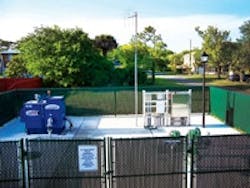Pump Station Contingency Plan
Supplying alternative power to lift stations with a diesel-driven generator or an additional standby electric submersible pump has been the most cost-effective and logical standby plan, until now.
Lately, there has been an increasing shift from the conventional thinking of backup power to a new solution using surface-mounted backup pumps for lift station assurance. As new infrastructure is created and deteriorating infrastructure is improved, an alternative contingency plan is worth evaluating.
Standalone, diesel-driven pump systems provide uninterrupted service to customers while keeping sewage from polluting the environment. Neither generators nor electric standby pumps can guarantee this more effectively than a permanently installed independent backup pumpset.
Existing Solutions
A traditional duplex lift station typically contains a primary pump designed to handle peak flows and a secondary pump to handle the primary pump’s load in the event of a failure. Additionally, diesel-driven generators have provided electricity to lift stations in the event of a power outage. Some users have even found it feasible, though time consuming, to move a portable generator or portable pump from one lift station to another during outages.
Many sewage spills, however, have occurred with the above-described solutions, despite redundant designs and backup systems.
While some lift stations
continue to utilize electricity-dependent solutions, diesel backup options are gaining ground. Furthermore, there is a shift from utilizing the conventional diesel-driven generators to diesel-driven pumps, which can achieve 100% redundant lift station assurance.
Modern Approach
Year after year, surface-mounted, diesel-driven trash pumps with automatic self-priming and solids-handling capabilities have provided proven performance for sewer bypass applications. Taking these portable pumps and permanently installing them now provides a simple and reliable lift station redundancy strategy.
The versatile, independent backup pump not only provides pumping power during storm water infiltration or power outages, but is capable of pumping during scheduled maintenance, emergency repairs or new construction.
The standby pump includes programmable controls that utilize level sensors to initiate backup pumping and send an alarm to alert the operator that backup pumping had been engaged based on the level in the wet well. The pumpset continues to operate and pump the required flow and shuts off when either the wet well is lowered or the electricity is restored, and the primary system regains control.
A reliable priming system coupled to the high-efficiency pump is a key component of a backup pump system. Reliable and proven priming systems such the Thompson Pump Enviroprime system and OVT (Oil-less Vacuum Technology) system provide additional environmental advantages. The Enviroprime system does not spill pump fluids during initial prime and re-priming. The OVT has eliminated recirculating oil in the priming system.
Standalone pump systems are available in suction/discharge sizes of 3 to 18 in. with the ability to provide variable flows up to 11,000 gal per minute (gpm), heads to 430 ft, and solids handling up to 4.25-in. in diameter, depending on the unit specified or required for the lift station application.
Backup pumps are available with a variety of optional benefits like communication systems such as SCADA and autodialer interfacing. Pumpsets can be installed with sound-attenuated enclosures, eliminating noise disturbances to surrounding areas. Additional options can include a double-wall fuel tank, battery charger, audible alarms and flashing beacon lights.
Natural gas and propane also can be used as the fuel source if they are available at the site.
Initial and ongoing costs are lower with independent backup pumps. For example, in some areas, only certified electricians are qualified to work on generators, while pump operators routinely handle the testing of pumps, which also is safer than handling electricity.
St. Augustine Lift Station
An example of a lift station standby pump system is one that was specified by CDM Eng. and installed by Royal American Construction was in St. Augustine Beach, Fla. A large new subdivision was being built just blocks from the Atlantic Ocean and required a completely new lift station to be constructed. Engineers utilized this opportunity to specify a lift station with piping for a surface-mounted standby pumpset to be built.
A Thompson 4JSCM was permanently installed to handle the specifications of 210-gpm minimum capacity, 72-ft minimum total dynamic head, 3-in. minimum solids handling and 20 ft of maximum re-priming lift at 1,800 rpm. System training and thorough coordination of SCADA interfacing was accomplished through efficient communications, and the lift station went live in December 2010.
“We’ve seen an increasing demand for backup pumps instead of backup generators (for lift stations),” said Lane Fowler of Royal American Construction. “When given the opportunity, we recommend this solution every time. It’s the safer, smarter solution.”
Since then, the subdivision was completed and the lift station has provided uninterrupted service to customers through many storms and scheduled maintenance activities. Thompson Pump also provided an additional lift station backup pump system for the St. John’s County municipality of St. Augustine.
Sewage collection and treatment authorities are choosing backup pumping as the ideal lift station contingency plan. An investment in a permanent lift station backup pump is not simply a matter of convenience; it is an investment in the community and a commitment to a better environment.
The reliability of a self-starting pump unit that is independent of electric power reduces the risks associated with mechanical failure in both the traditional lift station and its usual generator-based contingency plan, along with providing more versatile uses. Independent backup pumps provide a 100% backup contingency plan, rather than just electricity backup.
With the capabilities of automatic start and stop, speed control and communication interfacing, these independent pumps prove to be a cost-effective solution.
Download: Here
